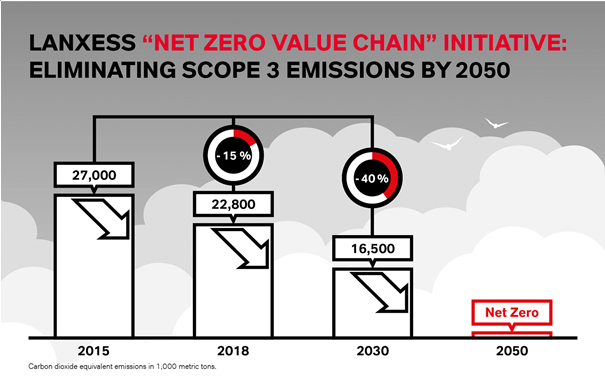Latest News:
● Scope 3 target: zero indirect emissions from upstream and downstream value chains by 2050
● Recognized by the Science-Based Carbon Target Initiative: LANXESS is committed to achieving the “1.5°C temperature control line” target
● Focus on sustainable raw materials, green logistics and climate neutral products
● 2040 target of climate neutrality in direct and purchased energy emissions (Scope 1 and 2) confirmed

LANXESS plans to make its entire value chain climate neutral by 2050.
12 August 2022 – Specialty chemicals company LANXESS has taken the next step in climate protection and has set a Scope 3 emissions target: The group plans to make its upstream and downstream supply chains climate neutral by 2050. This includes indirect emissions, especially from purchased raw materials, but also emissions from logistics and final products. By 2030, Scope 3 emissions will be reduced by 40% from the base year of 2015, from 27,000 ktCO2e to 16,500 ktCO2e. For direct emissions from production (Scope 1) and emissions from purchased energy (Scope 2), LANXESS set three years ago the goal of becoming climate neutral by 2040.
LANXESS’ climate targets are aligned with the Paris Climate Agreement and have been endorsed by the prestigious Science-Based Carbon Targets Initiative (SBTi). A joint initiative of climate protection group CDP, the United Nations Global Compact, the World Resources Institute and the World Wide Fund for Nature has confirmed LANXESS’ emissions reduction targets and confirmed that LANXESS is helping to limit global warming to a maximum of 1.5 degrees Celsius. This temperature is widely believed to be the threshold for preventing climate catastrophe.
Chang Mutian, Chairman of the Board of Management of the LANXESS Group, said: “In order to stop climate change, our society must transition to climate neutrality. We want to do our part. We will be climate-neutral by 2040 in terms of both direct and purchased energy emissions. The neutral target is already very ambitious. Combined with our additional scope 3 emissions target, we are taking the next step together with our suppliers and customers. SBTi recognises our commitment and shows that we are on the right track with responsibility superior.”
Luiz, CEO of the Science-Based Carbon Targets Initiative
Amaral said: “Lanxess is joining a growing number of companies today that set science-based targets to limit global warming to 1.5 degrees Celsius. We now need more companies to develop similar An ambitious goal like that of LANXESS.”
Strategize for a climate-neutral supply chain
In order to achieve the Scope 3 target, LANXESS has launched the “Net Zero Value Chain Initiative”. This strategy to achieve climate neutrality across the value chain is based on three pillars:
● Sustainable Raw Materials: LANXESS is realigning its raw material sourcing and is increasingly sourcing sustainable raw materials that are bio-based, recyclable or produced with renewable energy. Currently, such raw materials include sustainably produced cyclohexane for Durethan brand high-performance plastics, starch-based polyether polyols for Adiprene brand prepolymers, and more.
● Green Logistics: When choosing a shipping method, the CO2 footprint is more important than ever. LANXESS also intends to take advantage of innovative solutions, such as “green ships” with sustainable drive systems. Improvements in logistics planning are also aimed at increasing the utilization of transport assets, optimizing freight methods and reducing freight demand.
● Climate neutral products: LANXESS is expanding its range of climate neutral products and solutions with a lower carbon dioxide footprint. From autumn 2021, these products have a new brand: Scopeblue. Such products include trimethylolpropane (TMP), which is about half made from sustainable raw materials, and Tepex, a composite material based on flax and lactic acid. LANXESS’ medium-term goal is to provide low-carbon, climate-neutral alternatives to all products, and its long-term goal is to make all products climate-neutral by 2050. LANXESS also wants to be able to quantify the carbon footprint of all its products.
“We will continue to drive our product portfolio towards climate neutrality through our Net Zero Value Chain Initiative. In this way, we are also able to support our customers who are increasingly looking for sustainable solutions,” said Chang Mutian.

